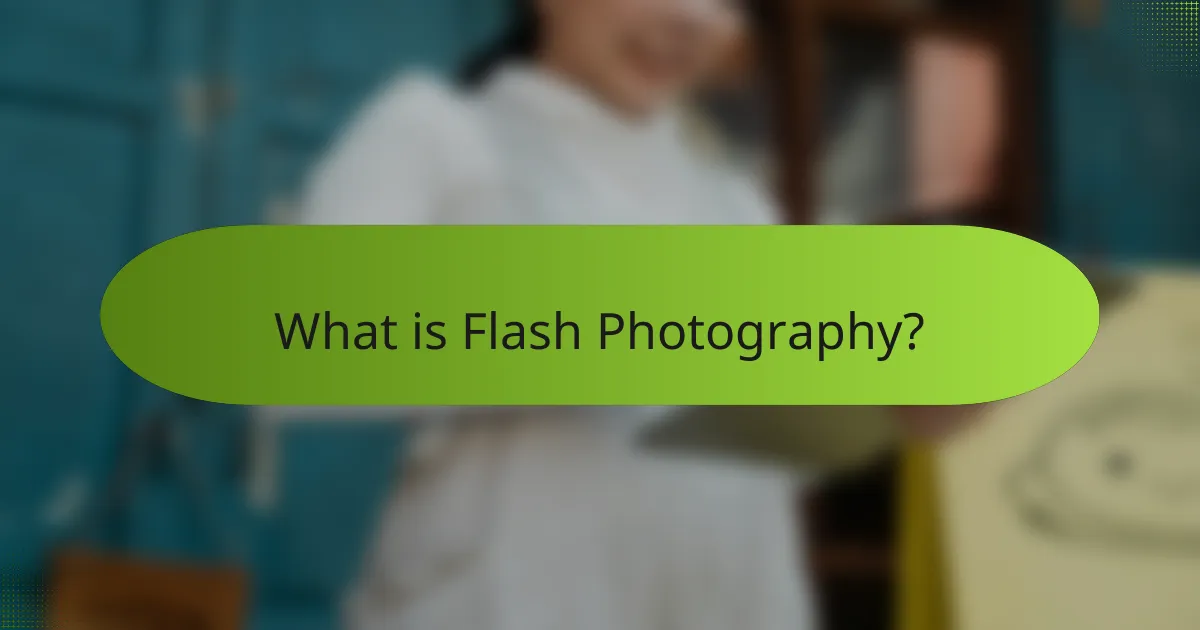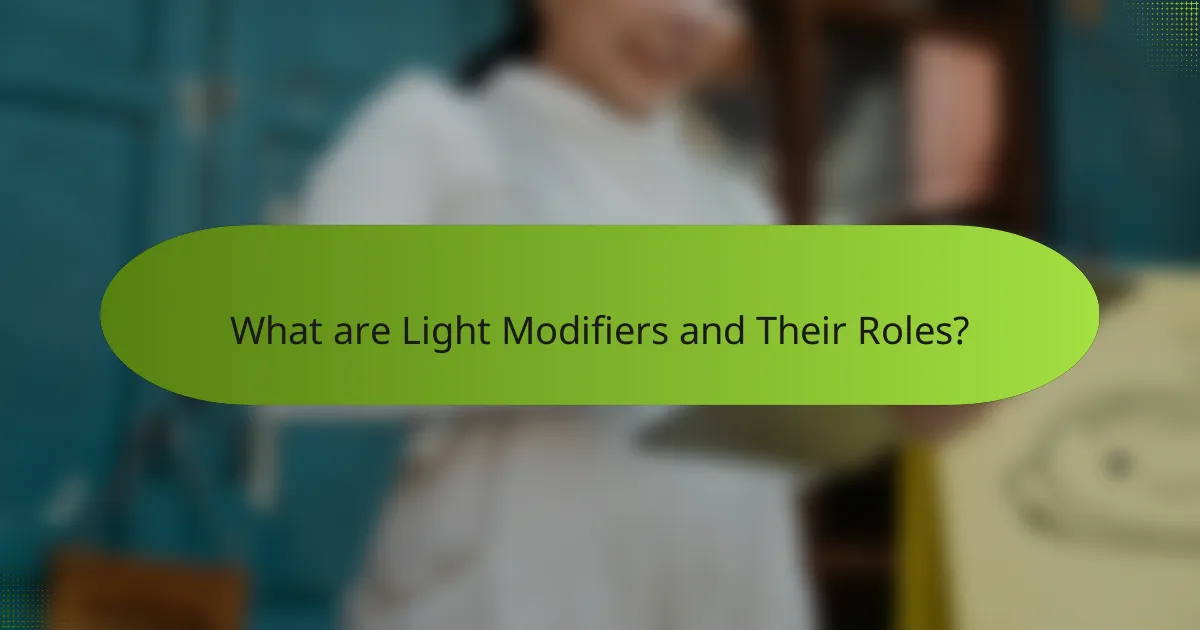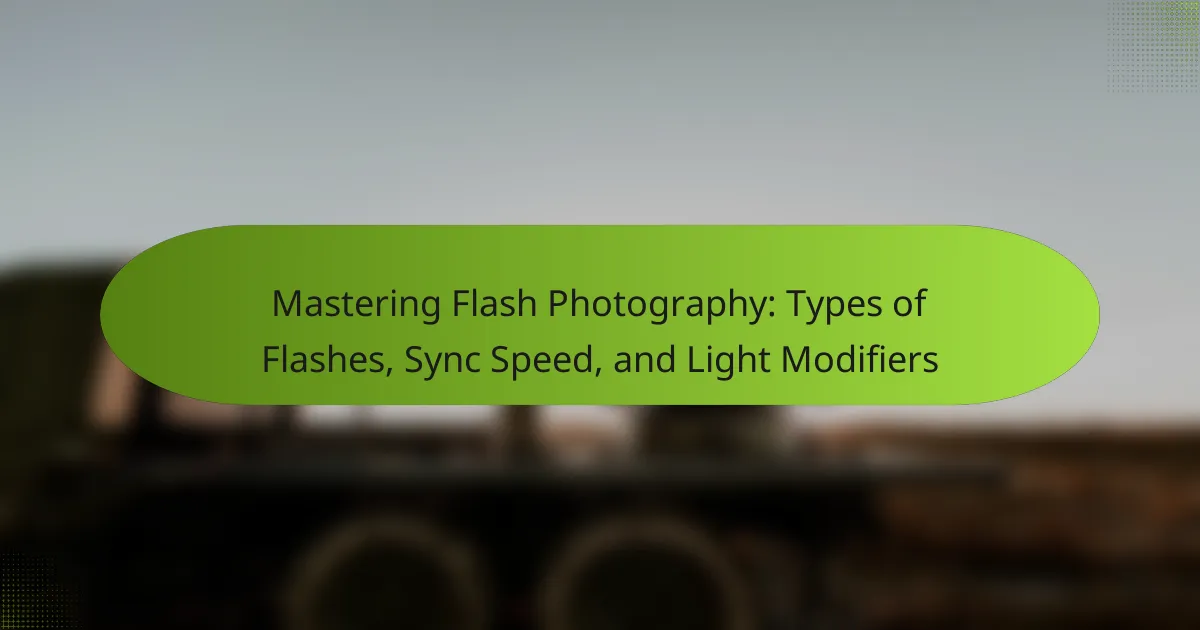
What is Flash Photography?
Flash photography is a technique that uses artificial light to illuminate a scene. It enhances the exposure of photographs, particularly in low-light conditions. Flash units can be built into cameras or used as external devices. The light produced by a flash is typically brief and intense. This technique helps to freeze motion and reduce blur. Flash photography is essential for capturing fast-moving subjects. It also allows for creative lighting effects. Many photographers utilize flash to achieve a specific mood or look in their images.
How does flash photography differ from natural light photography?
Flash photography uses an artificial light source, while natural light photography relies on sunlight or ambient light. Flash photography can illuminate subjects in low-light conditions. It allows for greater control over exposure and highlights. Natural light photography depends on the time of day and weather conditions. Flash photography can freeze motion effectively with a fast sync speed. Natural light photography captures softer shadows and more natural colors. Flash can create harsh lighting if not used properly, while natural light tends to be more flattering. Each technique has unique applications and artistic effects in photography.
What are the advantages of using flash in photography?
Using flash in photography enhances image quality and control. Flash provides additional light, improving exposure in low-light conditions. It helps freeze motion, capturing sharp details in fast-moving subjects. Flash also allows for creative lighting techniques, such as fill light and backlighting. This versatility enables photographers to shape shadows and highlights effectively. Moreover, using flash can enhance colors, making them appear more vibrant. Flash can also reduce the effects of harsh sunlight, softening shadows on subjects. Overall, these advantages contribute to more professional-looking photographs.
What scenarios benefit most from flash photography?
Flash photography is most beneficial in low-light conditions. It enhances visibility when natural light is insufficient. Events like weddings and parties often occur indoors or during the evening. Flash helps capture sharp images in these settings. Outdoor portraits benefit from flash by filling in shadows. This technique is crucial during bright sunny days. Flash photography also freezes motion, making it ideal for sports. It ensures clarity in fast-paced scenes. Additionally, it can create dramatic effects in creative photography.
What are the different types of flashes available?
The different types of flashes available include on-camera flashes, off-camera flashes, studio strobes, and speedlights. On-camera flashes are compact and mount directly on the camera. Off-camera flashes provide more creative lighting options by being positioned away from the camera. Studio strobes are powerful lights used in professional settings, often requiring external power sources. Speedlights are versatile and portable, commonly used for various photography styles. Each type offers unique features that cater to different photography needs and environments.
What is the difference between built-in and external flashes?
Built-in flashes are integrated into the camera body, while external flashes are separate units that attach to the camera. Built-in flashes are compact and convenient for quick shots. They often have limited power and range. External flashes provide greater power and versatility. They can be adjusted for different angles and distances. External flashes also support advanced features like high-speed sync and remote triggering. This flexibility makes them preferred for professional photography.
How do speedlights compare to studio strobes?
Speedlights are portable, battery-operated flash units, while studio strobes are larger, AC-powered lights designed for stationary use. Speedlights offer versatility and ease of use in various settings, making them ideal for on-location photography. Studio strobes provide higher power output and consistent lighting, suitable for controlled environments. Speedlights typically have a lower guide number compared to studio strobes, resulting in less light intensity. Studio strobes often feature advanced modeling lights and adjustable power settings, enhancing creative control. Speedlights are compact and lightweight, making them easier to transport. Studio strobes tend to be bulkier and require a power source, limiting mobility. Overall, speedlights excel in portability, while studio strobes dominate in power and versatility for studio work.
What are the unique features of ring flashes?
Ring flashes provide uniform lighting around the lens. This design minimizes shadows and highlights details evenly. They are particularly beneficial for macro photography. The circular shape allows for creative effects and unique lighting angles. Ring flashes often have adjustable power settings for versatility. Many models are lightweight and portable for easy handling. They can produce a catchlight in the subject’s eyes, enhancing portraits. These flashes are also compatible with various camera systems, adding to their usability.

What is Sync Speed and Why is it Important?
Sync speed is the maximum shutter speed at which a camera can synchronize with a flash. It is crucial for capturing images without any dark bands or exposure issues. If the shutter speed exceeds the sync speed, parts of the image may not be properly illuminated by the flash. Most cameras have a sync speed ranging from 1/200 to 1/250 seconds. Using a shutter speed faster than this can result in partial exposure. Understanding sync speed is essential for achieving balanced lighting in flash photography. Proper sync speed ensures full illumination and prevents unwanted shadows.
How does sync speed affect flash photography?
Sync speed determines the maximum shutter speed at which a camera can synchronize with a flash. If the shutter speed exceeds the sync speed, parts of the image may be underexposed or completely dark. This occurs because the shutter is not fully open when the flash fires. Most cameras have a sync speed between 1/200 and 1/250 seconds. Using a faster shutter speed can result in banding or uneven exposure. Understanding sync speed is crucial for achieving well-exposed flash photographs.
What is the standard sync speed for most cameras?
The standard sync speed for most cameras is typically between 1/125 and 1/250 seconds. This speed allows the camera shutter to fully open and close while the flash fires. Many consumer cameras default to 1/180 seconds as their sync speed. Professional cameras may offer higher sync speeds, such as 1/500 seconds or more. These speeds ensure proper exposure when using flash. Sync speeds vary based on the camera model and type of flash used. Higher sync speeds may require specific flash units or techniques like high-speed sync.
How can high-speed sync (HSS) enhance your photography?
High-speed sync (HSS) enhances photography by allowing the use of flash at shutter speeds faster than the camera’s native sync speed. This capability enables photographers to capture images in bright conditions without overexposing the highlights. HSS effectively reduces motion blur by freezing fast-moving subjects. It also allows for a shallow depth of field, which creates a pleasing background blur while maintaining proper exposure. Many modern cameras and flash units support HSS, making it accessible for various shooting scenarios. This technique is especially beneficial for outdoor portraits and action shots.
What factors influence sync speed in photography?
Sync speed in photography is influenced by several factors. The camera’s design determines its maximum sync speed. Typically, this speed ranges from 1/60 to 1/250 seconds for most cameras. The type of flash also plays a crucial role. Different flashes have varying durations of light output. This affects how well they can synchronize with the camera’s shutter.
Additionally, the focal plane shutter type impacts sync speed. Cameras with leaf shutters can achieve higher sync speeds than those with focal plane shutters. The flash duration itself is another factor. Shorter flash durations allow for higher sync speeds without motion blur.
Lastly, the settings used, such as aperture and ISO, can influence the effective sync speed. These settings affect exposure and can lead to variations in how sync speed is perceived in practice.
How do different camera settings impact sync speed?
Different camera settings significantly impact sync speed. Sync speed refers to the maximum shutter speed at which a camera can synchronize with a flash. The aperture setting affects the amount of light entering the camera, influencing exposure and potentially requiring adjustments to the sync speed. A wider aperture allows more light, which may enable the use of faster shutter speeds. Conversely, a smaller aperture reduces light, possibly necessitating a slower shutter speed to maintain proper exposure.
ISO settings also play a crucial role. A higher ISO setting increases sensor sensitivity, allowing effective exposure at faster shutter speeds. However, this can lead to increased noise in the image. Shutter speed itself directly determines sync speed. Most cameras have a specific sync speed, typically between 1/125s and 1/250s. Exceeding this speed can result in partial exposure, as the shutter may not fully open when the flash fires.
In summary, adjusting aperture, ISO, and shutter speed can all impact sync speed, affecting the overall exposure and quality of flash photography.
What are the limitations of sync speed in various lighting conditions?
Sync speed limitations vary with lighting conditions. In bright light, high sync speeds are necessary to avoid overexposure. Standard sync speeds, typically around 1/200 to 1/250 seconds, may not freeze motion effectively in these scenarios. In low light, slower sync speeds can introduce motion blur if the subject moves. This occurs because the camera’s shutter remains open longer, capturing more ambient light. Additionally, using flash at lower sync speeds can result in uneven lighting across the image. This is due to the shutter curtain blocking part of the flash duration. Understanding these limitations helps photographers choose appropriate settings for different environments.

What are Light Modifiers and Their Roles?
Light modifiers are tools used in photography to alter the quality and direction of light. They include softboxes, umbrellas, reflectors, and grids. Each modifier has a specific role in shaping light. Softboxes diffuse light, creating a softer shadow. Umbrellas can either reflect or diffuse light, depending on their orientation. Reflectors bounce light back onto the subject, enhancing illumination. Grids focus light into a narrower beam, controlling spill. Using light modifiers improves the overall quality of photographs. Their roles are essential for achieving desired lighting effects in various shooting conditions.
How do light modifiers enhance flash photography?
Light modifiers enhance flash photography by altering the quality and direction of light. They help create softer, more flattering illumination. Modifiers include diffusers, reflectors, and softboxes. Diffusers scatter the light, reducing harsh shadows. Reflectors bounce light, filling in shadows and adding highlights. Softboxes create a larger light source, resulting in softer light. Using these tools improves the overall aesthetic of photographs. Studies show that modified light can significantly enhance skin tones and textures. Proper use of light modifiers leads to more professional-looking images.
What are the most common types of light modifiers?
The most common types of light modifiers include softboxes, umbrellas, and reflectors. Softboxes diffuse light to create a soft, even illumination. They are often used in portrait photography to reduce harsh shadows. Umbrellas can either reflect or diffuse light, providing versatility in lighting setups. Reflectors bounce light back onto the subject, enhancing brightness and reducing shadows. Each modifier serves to control and shape light effectively.
How does the choice of modifier affect the quality of light?
The choice of modifier significantly affects the quality of light in photography. Different modifiers alter light’s softness, direction, and intensity. Softboxes produce diffused light, reducing shadows and creating a gentle look. Umbrellas spread light broadly, enhancing coverage but may lack control. Grids focus light, creating sharp shadows and directing it precisely. Reflectors bounce light, adding fill without harshness. Each modifier’s design influences how light interacts with subjects. For example, a softbox results in a more flattering portrait than a bare flash. The quality of light impacts mood and texture in images.
What should you consider when choosing light modifiers?
When choosing light modifiers, consider the desired effect on light quality and direction. Different modifiers, such as softboxes and umbrellas, create varying levels of diffusion. The size of the modifier influences the softness of the light; larger modifiers produce softer light. Portability is also crucial; some modifiers are more compact and easier to transport. Compatibility with your lighting equipment matters; ensure the modifier fits your flash unit. Additionally, consider the material; some materials reflect light better than others. The ease of setup and adjustment can impact shooting efficiency. Lastly, budget constraints will affect your options; higher-quality modifiers often come at a premium.
How do size and shape of modifiers influence light spread?
The size and shape of modifiers significantly influence light spread in photography. Larger modifiers create a broader light source, resulting in softer and more diffused lighting. This effect reduces harsh shadows and evenly illuminates subjects. Conversely, smaller modifiers concentrate light into a tighter beam. This leads to more defined shadows and higher contrast in images.
The shape of the modifier also plays a crucial role. Round modifiers produce a more natural light spread, mimicking the sun’s qualities. Rectangular modifiers can create directional light, allowing for specific lighting effects.
Research indicates that light quality and direction are essential for achieving desired photographic outcomes. For example, a study by West and Sweeney (2019) shows that larger softboxes improve light diffusion and reduce shadows. This demonstrates the importance of selecting the right modifier size and shape for effective light control in photography.
What materials are light modifiers made from and how do they affect performance?
Light modifiers are made from various materials, including fabric, plastic, and glass. Each material impacts the quality and character of light produced. Fabric modifiers, such as softboxes, diffuse light and reduce harsh shadows. Plastic modifiers, like reflectors, redirect light and enhance brightness. Glass modifiers, such as gels, can change the color temperature of the light. The choice of material affects durability, portability, and ease of use. For example, fabric is lightweight and collapsible, making it ideal for on-location shoots. Meanwhile, glass provides precise color control but is typically heavier and more fragile. The performance of light modifiers is therefore closely linked to the materials used in their construction.
What are some practical tips for mastering flash photography?
To master flash photography, practice adjusting your flash settings based on the environment. Use manual mode to control flash output and exposure. Experiment with different angles to create dynamic lighting. Utilize light modifiers like softboxes or umbrellas for softer light. Keep an eye on your sync speed to avoid motion blur. Test your flash in various scenarios to understand its effects. Review your images to learn from mistakes and successes. Consistent practice will enhance your skills over time.
How can you effectively balance flash with ambient light?
To effectively balance flash with ambient light, adjust the flash output and camera settings. Start by setting the camera to a low ISO to reduce sensitivity to light. Use a wide aperture to allow more ambient light in. Adjust the shutter speed to control the exposure of ambient light. Sync the flash with the shutter speed to avoid overexposure. You can also use flash compensation to fine-tune the flash output. This method ensures the flash complements the ambient light rather than overpowering it. Balancing these elements results in a well-exposed image that captures both the subject and the environment.
What common mistakes should you avoid in flash photography?
Common mistakes to avoid in flash photography include improper flash exposure settings. Using incorrect power settings can lead to overexposed or underexposed images. Failing to adjust the flash sync speed can result in partial images or black bands. Not considering the distance between the flash and the subject can affect lighting quality. Neglecting to use diffusers or reflectors may produce harsh shadows. Overlooking the background can lead to distracting elements in the photo. Lastly, not practicing with the flash can hinder skill development and creativity.
Flash photography is a technique that utilizes artificial light to enhance image exposure, particularly in low-light conditions. This article covers various aspects of flash photography, including the types of flashes available, the importance of sync speed, and the role of light modifiers in shaping light quality. Key topics include the differences between built-in and external flashes, the advantages of using flash for specific scenarios, and practical tips for balancing flash with ambient light. Understanding these elements is essential for photographers seeking to improve their skills and achieve professional-looking results.
